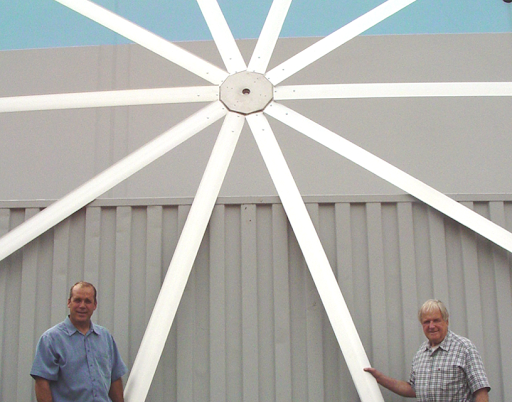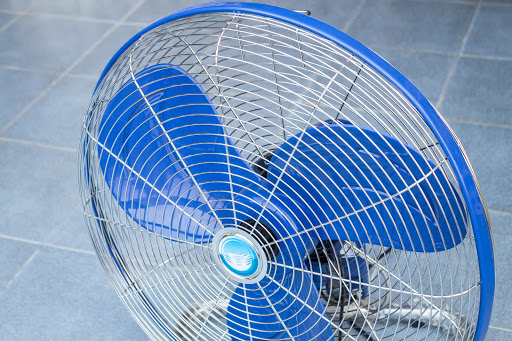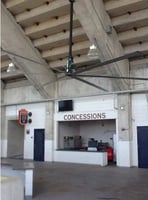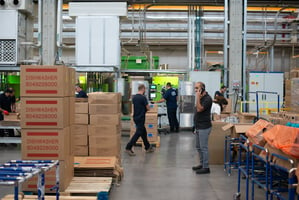HVLS fans have won over many owners and operators in a wide range of industries because they help...
High Volume Low-Speed Fans: The Complete Guide
This is the most comprehensive guide to High Volume Low Speed Fans you’ll ever need. In this guide, you’ll learn everything you need to know about creating airflow and moving large volumes of air in your space in an efficient, cool, and low-cost way.
With energy costs increasing across the world and health standards becoming more important than ever, HVLS Fans are essential to keeping costs down and keeping employees safe.
The question is: how can you keep your employees and customers safe and comfortable, while not breaking the bank on energy bills? Well, that’s where this ultimate guide comes into play.
History of HVLS/About Us

The idea behind a large ceiling fan that moves at a low speed and is capable of moving a large amount of air, required minimal maintenance and produced minimal noise was one out of need. Walter and Eddie Boyd, the founder of MacroAir and inventor of the High Volume Low-Speed Fan (HVLS) noticed cows wouldn’t produce milk if it got too hot. In 1998, the University of California Riverside’s Agriculture Department approached Walter (founder of MacroAir Fans) with the challenge of cooling cows to increase milk production during the hot summer months. His solution was to invent an oversized industrial fan that keeps livestock cooler and more comfortable. The solution was the world’s first HVLS fan and in 1999 the first fan shipped.
In 2003, MacroAir was formed and has been innovating the industry ever since. MacroAir currently has a large national and international distribution network. We know how to move air!
How High Volume Low Speed Fans Work
HVLS fans utilize their size to move large amounts of air. HVLS fans create a breeze that reduces the effective temperature (how hot you feel) by up to 8°F.
So what is the science behind HVLS fans? HVLS fans move large amounts of air, thus breaking up the moisture-saturated boundary around the body. This speeds up the body’s natural evaporation to produce a cooling effect. HVLS ceiling fans produce a large column of air as they spin and this moves air down and along the floor. As more air gets pushed toward the floor, the air moves forward until it reaches a sidewall and then moves back upward creating a circulation of airflow. This circulation also has a positive effect in reducing humidity that you don’t get with typical industrial fans or blowers. In the reverse direction HVLS fans create a gentle updraft that forces warm air off the ceiling and down, keeping your employees warm in the winter months!
Big Fans vs Small Fans

Due to its size (8-24′ diameter), one HVLS fan can replace several smaller fans. Not only that, because HVLS fans spin at a much slower rate, they are also quieter than small high-speed fans. Additionally, an HVLS fan delivers a large column of air that can travel much further than a small fan. Small high-speed fans dissipate air quickly, but have more friction between the moving air and stationary air and can’t create the same cooling effect that an HVLS fan can.
One major benefit of HVLS fans is that they save floor space on your production or distribution floor. Traditional ground fans take up a lot of space and can create hazards for employees that might trip over the fans or cords. Big HVLS fans are up on the ceiling and out of everyone’s way. Check out our complete post on why bigger industrial fans are better to learn more.
Heating and cooling benefits of High Volume Low Speed Fans
Have you ever been out somewhere and looked at the weather app on your phone and thought, “it feels much cooler than this!” or “it feels much warmer than this!”. Well, that’s exactly how fans work to either keep you cool or warm you up for year-round comfort. Based on the principle that air movement or wind chill affects how we “feel”, fans can help our bodies regulate to be comfortable.
Air movement increases the rate our bodies lose heat due to convection and evaporation. The moving air displaces warmer air that is in contact with our body and enhances the heat transfer rate. This makes us feel cooler. You can see this same principle in action with food. If you blow on hot soup, it will cool down faster than if you let it sit.
In the winter months, you can reverse an HVLS fan and create a gentle updraft, reducing the need for winter heating and reducing those annoying heating bills. This will force warm air to move from the ceiling down to the ground, keeping your employees comfortable.
Are High Volume Low Speed fans quiet?

HVLS Fans are much quieter than small fans and HVAC systems. Small fans have to spin much quicker than large ones and produce noise levels up to 80 decibels! HVAC systems require several mechanical parts to move air and are also a noisier option than HVLS fans. If having a quiet and comfortable work environment is important to you, then an HVLS fan is your best bet.
Do High Volume Low Speed Fans Improve Air Quality?
The EPA has highlighted the importance of increased ventilation in decreasing the number of air pollutants or contaminants in the workplace and homes. Big HVLS fans can move a lot of air and do a great job of replacing stale air with fresh air. While HVAC systems will also help with this, they consume a lot of energy and don’t typically take in air from the outside. Furthermore, maintenance is costly.
A great benefit of HVLS fans is that they can work on their own or supplement an HVAC system in replacing stale air with fresh air, resulting in big cost savings. Most buildings should have exhaust systems in place, but they can fail if doors or windows remain open and the air looks for the path of least resistance. HVLS fans will continuously mix incoming fresh air, continuously improving indoor air quality. Check out our blog on how HVLS Fans Improve Ventilation to learn more.
Choosing the right High Volume Low Speed fan for your space

If you’re thinking about getting an HVLS fan for your space, look no further than MacroAir. We’re the inventors of HVLS fans and continuously develop new technologies to move air quietly and effectively. Whether it’s for your warehouse, brewery, restaurant, or agricultural space we can help you move air. Not sure what size or model? Contact our knowledgeable customer care representatives who will gladly assist you in finding the perfect fan for your space.
Learn More
In this guide we looked at everything there is to know about high volume low speed fans. From how ceiling fans work, to keeping your employees cool, to meeting air quality standards, and even how to choose the right fan for your space. We even tackled how high volume low speed fans can reduce heating costs in the winter and provide additional cooling in summer. As the experts and inventors of HVLS, our family is passionate about helping our clients get the most high-quality fans possible.
Want to learn more about HVLS fans? Visit our website today to find more information about MacroAir's superior product line.

